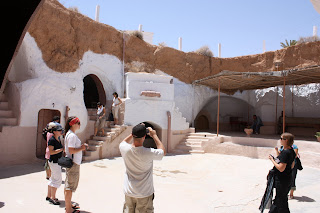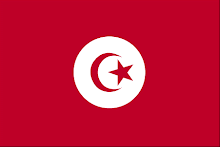

After our amazing night in the desert we crossed the width of Southern Tunisia, stopping at numerous sites to gape at the unreal traditional architectural characteristics of the arid region including troglodyte (underground) houses, semi-troglodyte (built into the side of a hill) houses and the fortified graneries called Ksars.
Before arriving at our first real stop we made a quick break at an overlook at Tamezret, which overlooks the Nefzaoua valley and shows the incredible terraced agriculture employed to limit erosion and capture all possible water. It reminded me so much of the rice terraces of the Philippines and Laos - minus any greenery.



The troglodyte houses in this region are stunning. From above these troglodyte houses resemble bomb craters. Berbers developed these naturally temperature-controlled structures. The brilliance of digging a house underground or into the side of a hill is not to be missed: the desert naturally lacks such building supplies as wood with which to build, but far more importantly, digging one's house underground utilizes nature's natural heating and cooling systems. In the summer, the ground underneath the scorching sand stays cool, having retained the previous night's lower temperature and of course avoiding direct exposure to the sun. In the winter (the desert gets very cold) the underground houses retain the summer's heat.


We viewed a number of these troglodyte houses in Matmata, a village of about 100 people made famous for being the setting for the home planet of Luke Skywalker . We stopped at Hotel Sidi Driss which became a hotel after its use in Star Wars (and if for some crazy reason you went there without knowing this it has plenty of signs - such as a very tacky old Star Wars towel tacked up on a wall). It has five pit courtyards connected by underground tunnels.

Next we went to Medenine to see one of the best Ksars in in the region. A Ksar is a Berber's traditional fortified grainery that preserves and protects the grain crops produced in good seasons. Each Ksar has many ghorfas (literally translates in Arabic to "rooms"), long, narrow cave-like rooms that house the grains. Each family in the village would have a ghorfa. A caretaker (usually a religious figure in the community) would regulate the amount to be taken out by the owners during times of scarcity and in this way the Ksar acted as a "food bank." The ghorfas are stacked 3 and sometimes even four high, with crazy stone stairs built to reach them. A pulley system was used to raise and lower the grains from the higher rooms.


The Ksar was one of the craziest looking structures I've seen, and it was easy to fantasize that these were actually dwellings rather than food storages (and thus they have been represented in movies as desert dwellings rather than as boring food houses).

As there was a clear shortage of buffet-style feeding options for 45 tourists, our guide had arranged for an amazing lunch served in a traditional Berber troglodyte bed and breakfast (I know, right!). We ate a regional meal of lamb, cous-cous, salad and plenty of fruit, after which we were stuffed (due to the insistence of the matriarch feeding us). The woman and her children who lived there were very funny, speaking little English but more than happy to gesture wildly. as there were far more of us than there were cave dining rooms, I ate lunch with a small group on the floor of one of the bedrooms, and promptly passed out for a brief nap afterward.


After lunch we once again piled into the bus and made our way to the east coast and over a long bridge to the island of Jerba - the Land of the Lotus Eaters in Homer's Odyssey, in which the crew didn't want to leave after drinking the sweet beverage (the same one I had tried to days earlier back in Tozeur I mentioned in that blog).
We were set up in a very nice hotel and I immediately headed for the beach, where I was able to do one of my favorite things in the world - riding a horse on the beach.




No comments:
Post a Comment